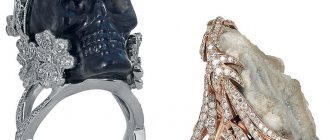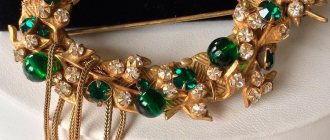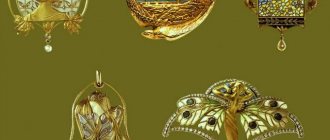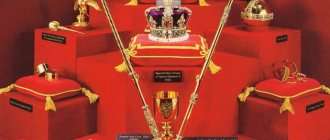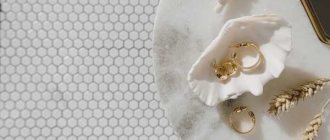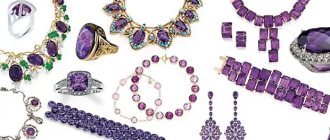The term “art deco” (or art deco) comes from the French art déco, a common abbreviation for the exhibition of decorative arts that took place in 1925 in Paris and had a significant influence on the development of architecture, design (including jewelry) and fashion in the first half of the 20th century. century.
Advertising - Continued below
Bold, edgy jewelry gained popularity in the 1920s and 30s and returned to the list of favorites among a variety of jewelry designers a few years ago.
What is Art Deco?
Leaf from the album Feuillets d'Art. 1919
Leaf from the album Les choses de Paul Poiret vues par Georges Lepape. 1911
Leaf from the album Modes et Manières d'Aujourd'hui. 1914
Art Deco, which means “decorative arts” in French, is the name of the artistic style that reigned in Europe and America after Art Nouveau, between the two world wars. Moreover, it reigned mainly in industrial design - fashion, jewelry, posters, facades, interiors, furniture. This happened while the “great art” of that era was experimenting with expressionism, abstractionism, constructivism and other -isms, which, of course, are brilliant, but not everyone will be able to see them constantly in their apartment. And Art Deco items are intended specifically for everyday life - very rich, luxurious and impressive, but still everyday.
Art Deco era and jewelry technology
Alfred Van Cleef and Julien Arpels invented an invisible setting for gemstones in 1935. Grooves were cut into rubies, sapphires and diamonds, the stones fit closely to each other, the metal was completely covered. Thanks to this new product, and after it, others began to create real masterpieces in the Art Deco style.
By the 1930s, Art Deco jewelry had become widespread as both European countries and America began to create items that were accessible to a wide range of buyers. These were clip brooches made of diamonds, sautoirs (from the French “porter en sautoire” - to wear over the shoulder) and bracelets, where small diamonds emphasized the ornamental lines of clear flat patterns. You can still find many similar jewelry in antique stores today.
Throughout the world, the period of dominance of the Art Deco style lasted between the First and Second World Wars. But his figurative structure and the techniques used turned out to be so universal that they still look bright and modern to this day.
(Visited 1,009 times, 1 visits today)
How to recognize an item in the Art Deco style?
Cigarette cases, powder compacts. 1930s. Kyoto Fashion Institute
Vogue magazine cover with an “optical” dress by S. Delaunay. 1925. Press service of the Kremlin Museums
Handbags. OK. 1910. Kyoto Fashion Institute
This thing will definitely be beautiful - stylish, elegant. It is made of a material with an expensive texture, but not flashy luxurious, but simply valuable. The colors will be complex shades, there will be a lot of black. Often the author clearly used a ruler - but at the same time managed to very elegantly round all the corners. Geometric patterns are constructed according to careful proportions and have the ability to hypnotize. There are also often inclusions of something ancient Egyptian or Japanese, but in some strange design: Art Deco loved to reinterpret exotic cultures. (By the way, “Russian exoticism” was also valued.) I liked the style and technical progress - that’s why there are stylized trains flying at great speed, and the propellers of airplanes and ships.
How to wear
Art Deco is a style that does not tolerate everyday life. It is suitable for special occasions: festive events, special meetings, ceremonies and holidays. Jewelry in this style should be combined with knee-length or floor-length dresses: clothes should have soft, flowing lines. Materials: delicate velvet, translucent silk and chiffon.
Art Deco clothing and jewelry draw attention to the female body. A deep neckline, bare shoulders, and open back go perfectly with necklaces - chokers, necklaces, beads, and long earrings.
Video
Style in fashion
Evening Dress. Fashion designer Madeleine Vionnet. 1927. Press service of the Kremlin Museums
Evening Dress. Lanvin fashion house. Around 1925. Press service of the Kremlin Museums
Dress. France. Winter 1922. Fashion house "Sisters Callo"
Art Deco is most noticeable in women's fashion. In the era when this style reigned, women began to cut their hair short, finally freed themselves from rigid corsets and crinolines, the waist either slipped onto the hips, or rode up right under the chest, and the skirt was shortened to a height that was completely indecent, in the opinion of those who remembered Victorian morality.
The creators of the style - the great fashion designers Paul Poiret, Mariano Fortuny - cited kimonos, Arab turbans and trousers, antique tunics and tables, medieval cloaks. One-piece clothes appeared, draperies, heavy fabrics, chic and shine were everywhere. In such loose clothes, embroidered with iridescent pearls, bugles, rhinestones, and beads, it was great to dance new lively dances - foxtrot, Charleston, tango. In general, let's remember the era of The Great Gatsby.
Style in jewelry
Van Cleef and Arpels brooch. 1930
Van Cleef and Arpels collar necklace. 1929
Egyptian style brooch Van Cleef and Arpels. 1924
The companies Cartier and Van Cleef & Arpels, as well as other jewelry houses, deliberately worked according to the principles of Art Deco in their works. After the fluid forms and poetic flowers of the Art Nouveau era (aka Art Nouveau), their jewelry seemed flashy and shocking.
From the history of jewelry: Art Deco style
As you know, the art deco style owes its birth to several sources, including the art nouveau style (Art Nouwau), cubism, the German Bauhaus and, paradoxically, archaeological finds of the beginning of the century, which caused a craze for the culture of Ancient Egypt with its laconic perfection shapes and lines. The Russian ballet seasons of S. Diaghilev also played a role, delighting Europe not only with an innovative approach to ballet art, but also with very original, bright, very expressive costumes and scenery.
Speaking about the Art Deco style, it should be noted that it dominated the era between the two world wars, and became a reflection of a radically changed world. The century of speed, scientific and technological progress, emancipation after the Victorian era... The rhythm of life is changing, the image of women is changing. This is no longer a naive and romantic girl, this is a vamp woman (Marlene Dietrich became the embodiment of ideas about the ideal). Simple, practical, and at the same time expensive clothes, passion for career, sports and jazz - all this required a new approach to the style of jewelry.
So, what does Art Deco jewelry look like? No floral elements or smooth lines - simple geometric shapes, clear lines and bold color schemes. When creating jewelry in the Art Deco style, leading jewelers combined seemingly completely incompatible materials into one product. Diamonds and enamel or onyx, precious and semi-precious stones, ivory, mother-of-pearl and coral coexisted perfectly in one product.
Many people call the Art Deco style industrial, thanks to its characteristic smooth, shiny white metals: platinum, silver, white gold, or even just alloys of different metals. The American jewelry store became famous precisely for its iconic Art Deco style, and in Europe, Cartier, Mauboussin, Van Cleef & Arpels produced world-famous products in this style.
The use of colored enamel or varnish created a striking color effect. In general, the combination of several rich colors at once in art deco jewelry is a characteristic feature of this style, inspired specifically by the Russian ballet seasons in Paris. A very popular combination of diamonds, rubies, amethysts, emeralds and sapphires, which at first glance seemed chaotic, was called the “fruit salad”.
Archaeological finds in Egypt, in particular the discovery of Tutankhamun's tomb in 1923, aroused increased interest in the culture of Egypt and the appearance of Egyptian motifs in the design of jewelry and bright combinations of turquoise, lapis lazuli, chalcedony and carnelian.
Indian motifs are expressed in Art Deco jewelry using ivory, horn, tortoiseshell, jade and ornamental stones.
The simplicity and laconicism of clothing styles contributed to the fact that very long multi-tiered necklaces, especially those made of pearls, large geometric pendants made of cold white metal with colored enamel or stones, and long earrings came into fashion. Bracelets became larger and often featured distinct oriental motifs. Brooches and pins decorated not only dresses and jackets, but also outerwear and hats. Ladies' cigarette cases designed in the Art Deco style appeared, since ladies could already afford to smoke in public places. In general, thanks to the models of Coco Chanel and Elsa Schiaparelli, jewelry has become not only an element of evening wear, but also an excellent addition to an everyday suit or dress.
Art Deco jewelry could be either extremely expensive, using precious metals and stones, or outright imitations, or even contain both elements.
Products by leading designers Boucheron, Cartier, Fouquet, Gerard Sandoz, and Van Cleef & Arpels, created in the Art Deco style, with precious stones in platinum, with expensive enamel in the colors of the Ballet Russes, were presented at an exhibition in Paris in 1925, where More than 400 jewelers demonstrated their products on an area of about 500 square meters.
After this, thanks to the possibility of using methods of chrome plating or varnishing of metals, the use of bakelite and artificial stones, mass production of stylish jewelry that was already accessible to every woman was begun. At the same time, Czechoslovakia began producing fashion jewelry using crystal, garnets and Czech glass of the highest quality, which were exported to various countries until 1939.
The Art Deco style continues to inspire leading jewelry designers today.
Was there Art Deco in Russia?
High-rise building on Kotelnicheskaya embankment. State Research Museum of Architecture named after A.V. Shchusev: culture.ru/institutes/7985
Metro station "Mayakovskaya"
USSR Pavilion at the International Exhibition in Paris. 1937. State Research Museum of Architecture named after A.V. Shchusev: culture.ru/institutes/7985
The brilliant Art Deco style is, of course, deeply “bourgeois”. This is a symbol of the lost generation, the fashion of the characters of Fitzgerald, Hemingway (as well as Wodehouse and the pre-war books of Agatha Christie). The young Soviet state in that era had no time for this external splendor. However, they had the “Roaring Twenties”, and we had the New Economic Policy. Remember Ellochka the Ogress: “...the sparkling photograph depicted the daughter of the American billionaire Vanderbilt in an evening dress. There were furs and feathers, silk and pearls, an extraordinary lightness of cut and a breathtaking hairstyle.” The Soviet Nepmen, of course, imitated their free Western neighbor in their habits, although this was not officially approved.
On the other hand, the imprint of Art Deco is noticeable in one of the most formal arts - architecture. The influence of imported style is easy to find in Stalinist classicism: photographs of fragments of Moscow high-rise buildings from some angles are difficult to distinguish from views of pre-war Manhattan skyscrapers. Art Deco's love for geometricism, the use of abstractions - all this was easily absorbed by Russian masters in the homeland of Suprematism. It was also appropriate to glorify the technical achievements of mankind. There are also more amusing signs - remember, we talked about Art Deco’s appeal to Egyptian motifs? It was thanks to him that obelisk lanterns appeared in front of the Foreign Ministry building on Arbat, and the entrance to the building itself became like the portal of an ancient temple. The same style is found in some Moscow metro stations (“Kropotkinskaya”, “Mayakovskaya”, “Airport”), the building of the Russian State Library, etc.
Jewelry House Cartier, which took Art Deco as a basis
In the 1920s and 1930s, the House of Cartier produced products that clearly showed the emergence of a new style. First of all, Cartier began to use simple shapes and compositions in the form of circles and segments, which he considered the most “feminine”. Then he mastered other figures. Their jewelry made of rock crystal, mother-of-pearl, jade, and onyx with clear, simple silhouettes was decorated with diamonds and other precious stones with a careful selection of colors.
But then the craftsmen who worked at the House of Cartier mastered “white art deco”, combining diamonds and white platinum with black enamel and black onyx. Thus, from black and white spots, a special “panther skin” motif was born, which was also used to create wristwatches. Thanks to “white art deco”, not only the company was enriched, but a whole new style was formed.
At that time, brooches in the form of baskets with flowers or vases with fruit, assembled from sapphires, rubies, and emeralds, were made on a colored background. The motif of a basket filled with flowers was very characteristic of Art Deco jewelry.
In 1925, an exhibition of modern industry and decorative arts was held in Paris, which became a true triumph for the House of Cartier. French jewelers Sandoz, Fouquet, Van Cleef, Despres, Mauboussin and others showed how the aesthetics of the newest era are born. Parisian jeweler Georges Mauboussin, already very well known in high society, received a gold medal.
